*This post is an implementation guide inspired by the adjacent user theory post by the wildly-successful Bangaly Kaba (EIR at Reforge, Former Vice President of Growth at Instacart, Instagram).
Adjacent users? Huh?
Maybe you’ve never heard the term before, but these people are the key to achieving rapid, sustainable SaaS growth.
The term was coined by Bangaly Kaba during his time leading growth at Instagram between 2016 and 2018.
In that time, the photo and video sharing network grew its membership from around 400 million users to over one billion.
If you’re a SaaS product manager, those kinds of numbers will have you on the edge of your seat.
One strategy that particularly contributed to this achievement was activating the adjacent users, and this is exactly what we’re going to focus on in this post. What adjacent users are and how to spot them, in order to convert them into more customers.
So let’s get started.
TLDR? Grab the key takeaways
- Adjacent users can be your quickest path to cash if you actually accommodate them.
- Adjacent users are those cute little lurkers that signed up, liked what they saw, and then… haven’t quite become activated.
- Adjacent users are NOT the ones who download your app and delete it within minutes; they're not the ones that don’t have a need for your app, and they're are not the people who need but hate your app.
- Adjacent users are those who need your app, like your app, but for some reason haven’t figured out how to make most of it in their daily life.
- The Adjacent User has simply got stuck in their user journey.
- Why? Maybe you failed to cater to their segment in your onboarding.
- Maybe there were too many obstacles for them.
- Maybe your positioning intimidates them and makes them think your product is not quite for them.
- The fact that adjacent users haven’t become properly activated doesn’t mean they are bad leads, it simply means you need to help them get ‘unstuck’.
- Your adjacent users are actually very similar to your ideal customer persona, and they are fairly easy to convert (and much cheaper).
How to help your adjacent users get unstuck?
- Look at your cohort analysis (use activation rather than churn as a benchmark) and analytics tools to identify the users who are underutilizing your product.
- Identify those users’ characteristics.
- Analyze the channels and campaigns those users are coming to you through.
- Track their in-app behavior.
- See how those differ from successfully activated users.
- Identify what could have possibly blocked their progress down the user journey (e.g. by looking at what features they are not using, or what they are often clicking on in your resource center).
- Create re-active proactive and re-active in-app experiences to help them adopt more features that will lead them towards activation.
How to exactly create these experiences though? Read on to find out.
What are adjacent users?
Hey, it’s Bangaly’s term so let’s use his definition:
The Adjacent Users are aware of a product and possibly tried using it, but are not able to successfully become an engaged user. This is typically because the current product positioning or experience has too many barriers to adoption for them.
They’re the people who make it part of the way along the user journey, but for some reason get stuck.
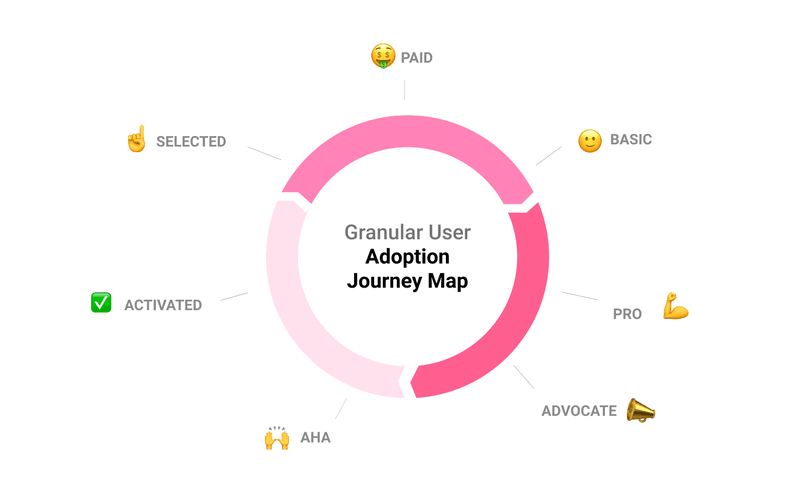
To give you a real-life example: I’ve been an adjacent user of LinkedIn for a good five years before I really started using it. I created my profile and only visited every few weeks at first.
It wasn’t until I started hiring, doing personal branding, and looking for joint venture partners that I graduated to become a fully activated, and then a power user. I started logging in every day (Ok, fair enough – I just never logged out 😉). I started using more and more features, I started writing posts and comments, I used polls, my network ballooned from a few hundred to over 1,500 connections.
And finally…lo and behold, after five years: I converted into a premium user.
So, looking at our own breakdown of the user adoption journey (above), adjacent users (AUs) are people who have experienced your product’s Aha! moment but are not willing or able to become activated.
So, these are people:
- Who are responding positively to your marketing and value proposition – and so are very similar to (hence 'adjacent to') your existing user base.
- Who you may well be paying for to acquire as triallists or new customers.
As Bangaly says:
While Instagram had product-market fit for 400+ million people, we discovered new groups of users who didn’t quite understand Instagram and how it fit into their lives. Our insight was that it is critical for growth teams to be continually defining who the adjacent user is, to understand why they are struggling, to build empathy for the adjacent user, and ultimately to solve their problems.
Adjacent Users are NOT:
- People who download your app and delete it within a few minutes.
- People who realise that they don’t have a need for your app, whether or not they like it.
- People who do have a need for your app, but dislike it for some reason.
They are people who try it, they have a need for it, they like it, but they still don’t activate.
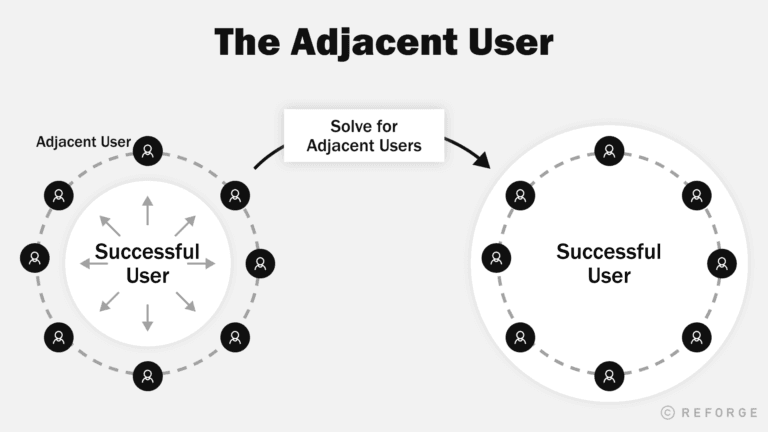
Instagram discovered that people who did not manage to collect more than ten followers within seven days of signing up for the platform were much less likely to activate and become regular (core) users.
Bangaly and his team put their efforts into these groups and the rest, as they say, is history.
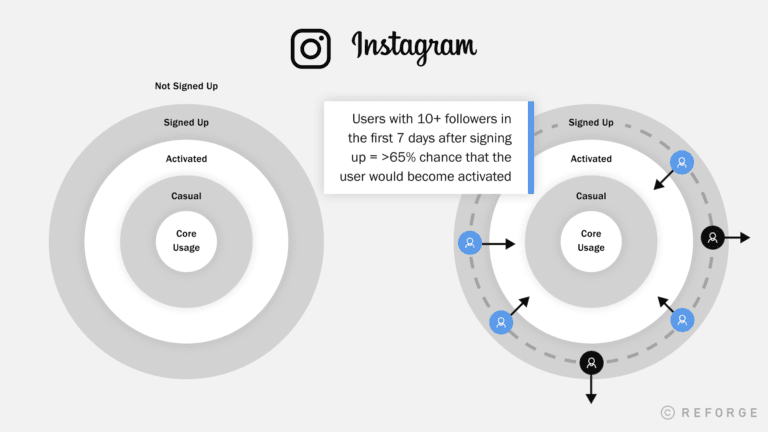
How to spot your adjacent users
If you want to identify and define your adjacent users, you need to know who is not progressing from Aha! to activation. This is best done by starting with a cohort analysis.
The image below measures churn by monthly cohort (i.e. new users coming on during any given month) but in this case, we need to be tracking conversion and non-conversion from the Aha! state to the activated state.
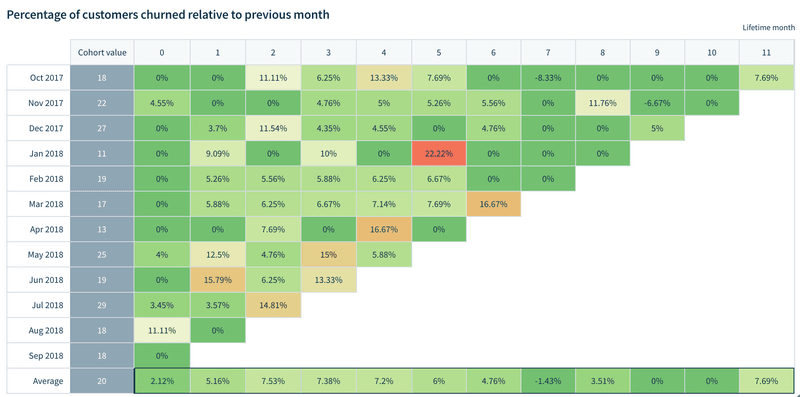
If this conversion rate is falling from cohort to cohort, it shows that there are AUs who are not quite getting to grips with your product.
They aren’t necessarily churning out, they might stay as signed-up users – especially if your product is free or freemium, they’re just not making progress towards becoming regular, engaged users.
Quantitative analysis of state-to-state change metrics like this can give you a sense of the size of your AU issue. But if you want to capture and convert them, you’ll also need to:
- Identify those users’ characteristics
- Analyze the channels and campaigns those users are coming to you through
- Track those users’ in-app behaviour
- And see how those differ from successfully activated users
Perhaps you’re losing a disproportionate share of triallists coming on board through PPC campaigns? Then maybe there’s a product-market fit issue arising from your ads and landing pages. Maybe people are coming on board expecting one thing and being presented with something different.
Perhaps a high percentage of the people dropping out have only used one of your product’s features? Then maybe your onboarding process is not making the value of the other features clear enough, or maybe it’s not making the user aware of those other features at all.
There could be any number of explanations, and the reason for non-activation will almost certainly not be the same for every adjacent user.
You are highly likely to have multiple adjacent user groups who differ from successful users in different ways.
Is this beginning to sound daunting? Starting to get worried? Don’t.
Adjacent users are among the easiest to convert, they offer the greatest ROI on your efforts, and addressing their needs gives you a clear route to sustainable growth, we’ll show you why in the next section.
Why you need to target adjacent users
There’s a school of thought in the SaaS world which maintains that activation is single most powerful variable you can target. Why’s that? Because users you fail to activate have cost you the full customer acquisition cost (CAC), while yielding the minimal lifetime value (LTV).
Fix your Activation rate and the LTV you can generate from a given CAC increases, the only way to do that via new business acquisition is to bring your per user CAC down.
What about retention or monetization as downstream variables to target? Of course they’re important, but if a user doesn’t activate, then you won’t have the chance to work on those variables! At best you’ll make a few dollars from them until they remember to cancel your service.

Optimizing your activation rate shifts your growth and revenue curves upwards by making your onboarding and product-market fit more efficient. And because most SaaS products are subscription-based, the effects cascade over time.
So why target the adjacent users in preference to other groups? Because the ratio of effort to reward is most favorable.
- You’ve already got them to try the product and to experience the Aha! moment.
- They’re almost the same as your successful users.
- The reasons why they’re not activating are not reasons you have control over (i.e. they don’t need your product or they just don’t like it)
Small adjustments to your marketing, your value proposition and your onboarding can therefore have a big impact on the numbers of users successfully activating when you address those adjustments to your adjacent users.
Strangely, a lot of SaaS product managers don’t think like this. They want to add new features, win new audiences, launch new products. They want to make big moves, not gradual gains.
Bangaly Kaba puts forward a couple of other explanations:
1. Too much focus on power users
Product managers pay too much attention to the problems of advanced users, because that’s where they sit on the user journey. They find it hard to see from the perspective of someone who is not quite aligned with their own experiences or their perception of the user
2. Personas don’t capture adjacent users
All the other problems with personas notwithstanding, the main one here is obvious. By definition, Adjacent Users are different from your current successful users in significant ways. When you’re thinking about AU, you’re thinking about next not present users.
Why are my adjacent users not converting?
Users fail to activate when they don’t experience the value your product offers – either at all, or quickly enough.
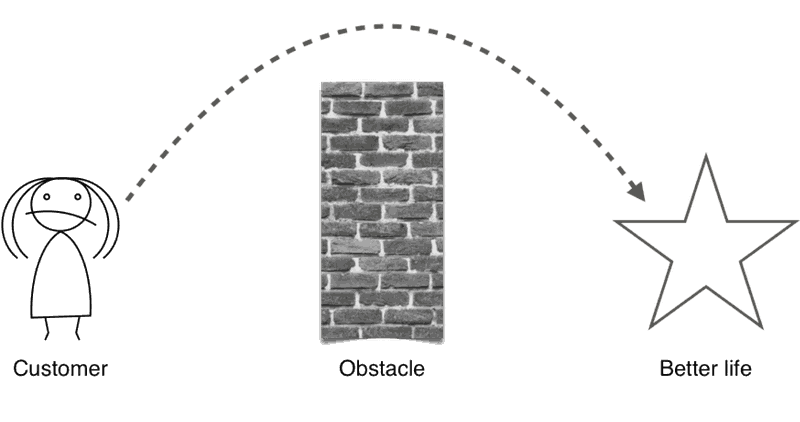
Your customer is at Aha! when they can see the better life on the other side of the obstacle. They activate when they finally experience it.
The activation event will differ for every SaaS product, maybe even for each use case a SaaS product solves.
We consider users to be activated when they have created a couple of workflows, installed our javascript on their website and discovered that all our functionality can be deployed without code.
For Slack, it’s using the app on more than three of the last seven days.

At Flatly.io, product managers found that one barrier to Activation was a non-linear workflow which led to people getting lost in the UI and not reaching the Activation moment.
They fixed that problem by making the workflow 'mistake proof'.
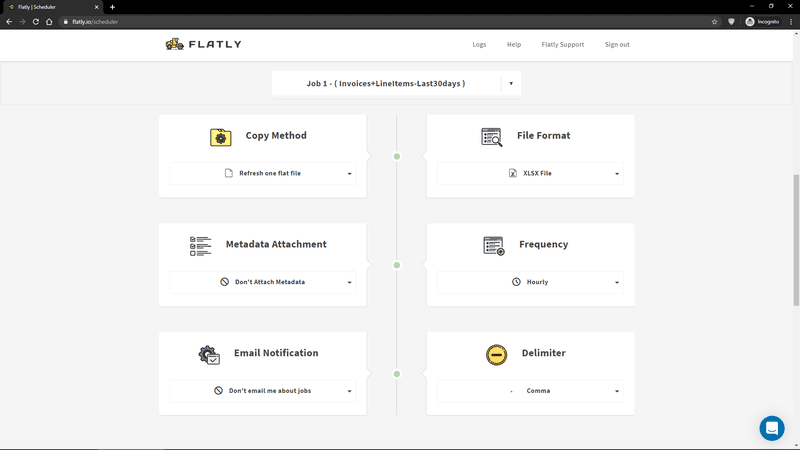
Kommunicate found that feature usage was a very reliable indicator of conversion likelihood – like many other SaaS products – and so their activation strategies are focused on increasing feature uptake.
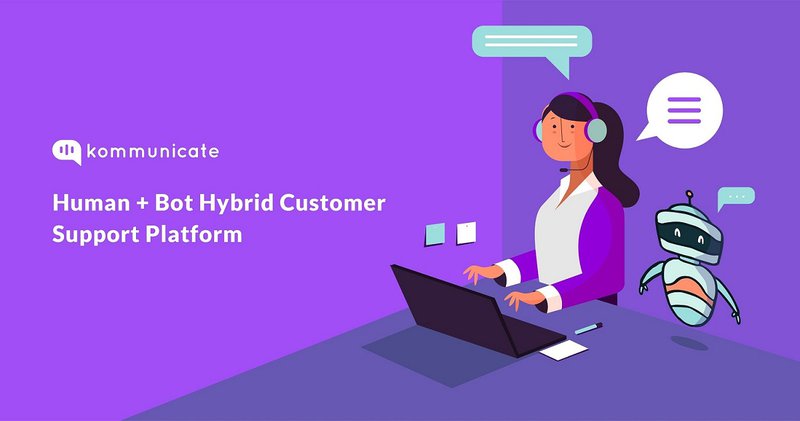
To understand why your adjacent users are not activating, look at your successful users and why they are activating.
If you know that your most successful users tend to be:
- Male
- Living in certain cities or states
- Willing to spend time going through your onboarding program
Then a suitable adjacent audience might be people who are identical in two respects, but differ in one. They might be:
- Female
- Living in other, different cities or states
- Not making it through the onboarding successfully
If you can create conditions where those people can succeed too, the pay-off will be great because these people are already well-aligned with your product.
The more closely you can associate a reason for not activating with one, or a small number of, divergences from the successful user profile, the easier it will be to solve for that group of AUs.
And this leads to what Geoffrey Moore, in his book 'Crossing the Chasm', calls the Bowling Alley strategy.
Each group of adjacent users you tackle should reduce the distance between your newly-broadened successful user group and the next nearest AU group, so:
- You will benefit from word of mouth within new networks
- Your case studies will be relevant to new segments
Just as toppling one pin at the bowling alley (hopefully…) knocks down those behind it.
So, the adjacent user theory of growth is focused on gradual expansion in concentric, ever-widening circles – with minimal effort required to take you outwards to the next layer.
Converting more adjacent users to customers
By catering for more use cases and ideal user journeys in your onboarding, you will:
- Get more groups of users experiencing the value of your service
- Get them to experience it more quickly
We’ll come back to ways you can achieve this in a minute.
Before we do, I’d like to deal with a question that keeps coming up time and time again. “Should I extend the trial period to improve activation?”
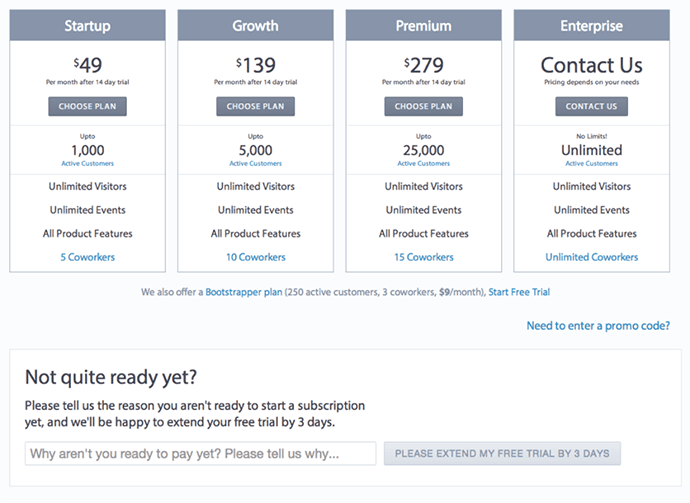
When you come to the end of a free trial with Trak.io, one of the options you are given is to extend the trial by three days.
All you have to do is give them a reason why you’re not yet in a position to buy.
Smart, huh?
If the reason the user gives is something that Trak.io can help them with, they can be directed straight to it with in-app cues.
If it’s not, it’s a strong signal of an issue Trak.io needs to address in its product roadmap or in terms of the kinds of users it’s attracting.
Win win, right?
Up to a point, yes.
Trak.io is doing this well, but a trial extension is not always the right answer. If a user hasn’t really engaged with your service at all during the trial, will a few days make the difference? If they have engaged with it and not experienced the value by the end of the trial, is there a wider time to value (TTV) problem with your app?
To make trial extensions work as a part of your activation strategy, you need to change something in the user experience that helps drive activation in response. Otherwise, more time is likely to lead to the exact same results, however, that’s not true for every app. Sometimes more time does make a difference, perhaps your SaaS is an accounting app that only gets used heavily once every month.
But as a rule, it’s better to get users to value faster than to give them more time to get there, and that’s why onboarding is so powerful.
We’ll look at three different aspects of this.
1. Onboarding: Identifying the Aha moment
If you’re not sure what a new user is looking for when they sign up for your service (for example, from the themes of the marketing campaign they responded to) then ask them!
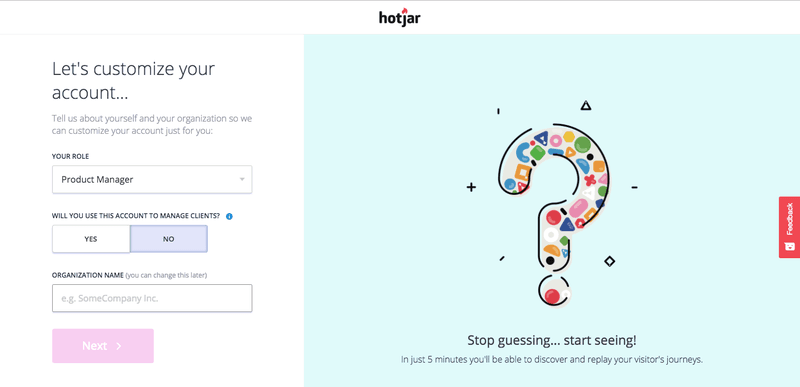
Here’s how Hotjar starts identifying users’ needs as part of the onboarding customization process.
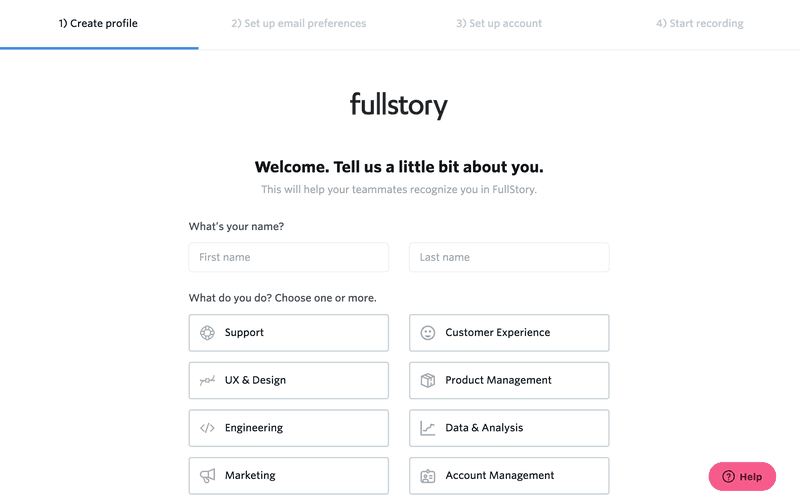
And here’s how it’s done at Fullstory.
This kind of microsurvey is a real win win:
- You win, because it tells you what type of user you’re dealing with and what success means to them.
- The user wins, because you can tailor the onboarding experience to get them to their preferred Aha! and value as quickly as possible.
But what about all those people whose needs fall outside the categories you already understand well? Like your adjacent users?
That’s where reactive onboarding helps.
This doesn’t have to be something that is done once and for all at the start of a user’s onboarding. There are plenty of ways to collect information about the sought-after Aha! by monitoring in-app behaviour through your product analytics.
Help center queries and FAQ page views give very strong signals about what a user is trying to achieve.
Combine a help center widget with an AI-powered bot like Drift or Helpcrunch’s and you’ve got a system that will start helping users to find their own ways to Aha and beyond by itself.
The advantage for you is that by studying their progress, you can build out proactive workflows for similar users to follow in the future.
2. Onboarding: tracking behavior
Heap, Mixpanel, Amplitude, there are loads of great in-app analytics packages out there which can help you understand how users are interacting with your product. If you don’t yet have clear mapped out segment by segment user journeys that you can provide proactive onboarding for, then Heap is probably the best of these three options. It tracks all activities from day one, rather than just those it has been configured to watch. But all these dedicated platforms are tricky and time consuming to use. If you’re not already an analytics guru, it’s often more efficient to use the analytics capabilities that are included in many one-stop-shop tools.
Once you can see what users are doing by group, you can cross-reference activity patterns against success.
What are the successful users doing that the adjacent users aren’t? Where are your adjacent users abandoning tasks? Are there features your adjacent users don’t seem to be aware of?
3. Adjusting user behavior
Once you know the problems your adjacent users are encountering, you can start to offer them solutions in-app. Even if you don’t know, you can make unsolicited suggestions about possible routes to value.
You know how Netflix suggests other content you might like when an episode ends? It’s the same here. You can anticipate what a user’s next move is likely to be – and help them to make it. User looks like they’re finishing up writing a document? Flag the spell checker function.
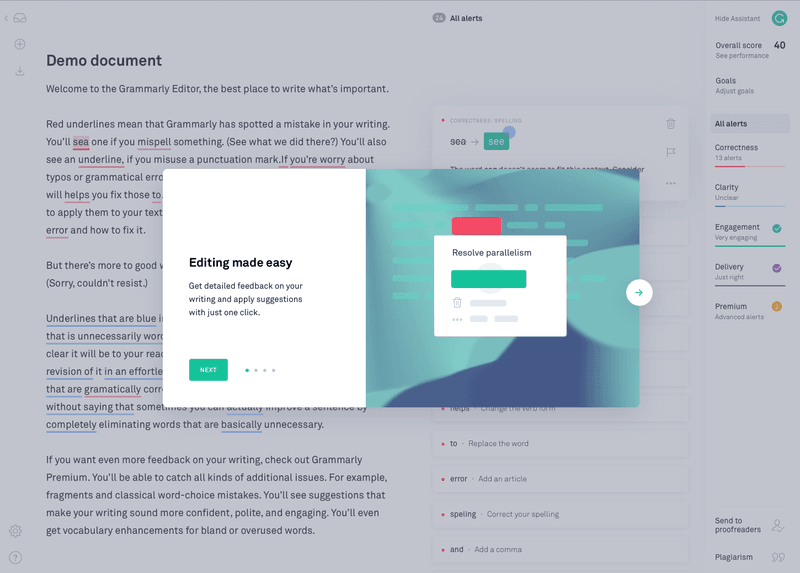
You can use any number of solutions to present custom advice of this type: models like the slide-out shown above; hot spots that draw attention to the relevant navigation option; pop-up tooltips; even complete interactive walkthroughs.
Onboarding checklists are a great way to discourage task abandonment. By showing how far a user has to go to get to the value, you take some of the uncertainty out of learning to use your service.
What if a user is struggling to picture success?
This is a common problem with some of the more complex SaaS tools out there. There’s so much freedom to customize that some users don’t know where to begin. We call this the empty state problem. Help them out by providing templates or part-completed use cases so they can see how other people have succeeded.
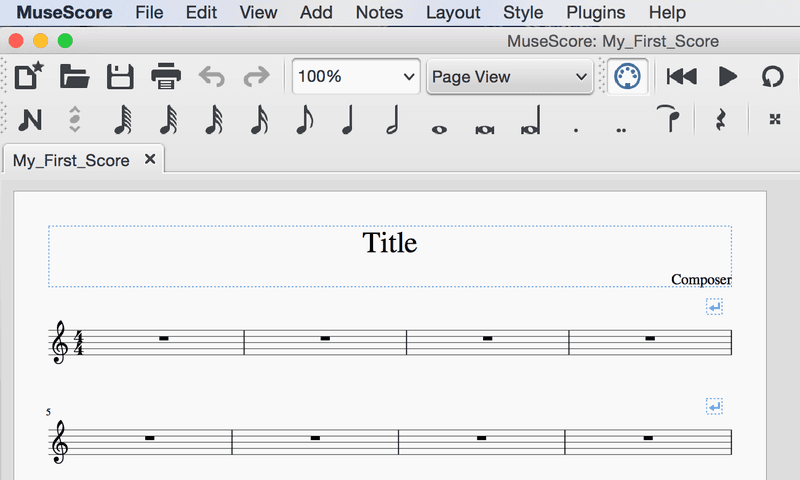
Muscsore makes it simple to write music by starting you off with an empty score you can fill in. While Trello helps users get started with a sample board that explains most of its key features.
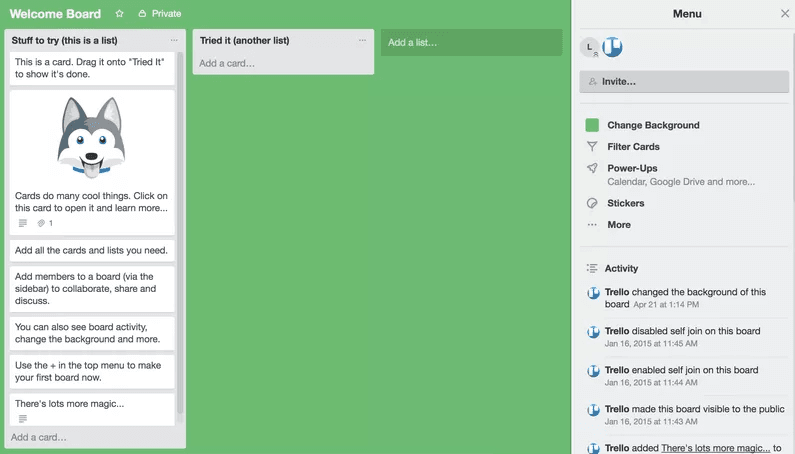
Remember, activation is not the end of the process
Users need to keep seeing value, so make sure you take advantage of the abilities of onboarding packages to keep flagging new sources of potential value to users:
- New and unused features
- New templates and use cases
- Premium features available only at certain subscription levels
Of course, it’s important not to interrupt tasks in process when you do this. Don’t muddy the waters and confuse your users.
And finally…
Of course, there are other ways to improve activation than better onboarding to solve adjacent users’ use cases:
- You can refine your marketing or product positioning, so as to bring in different types of new user who may be better suited to your product as it stands than the current AU groups. Of course, that’s risky – you could lose a steady inflow of successful familiar users in exchange for an untried segment by changing messaging.
- You can find new ways to monetize them. For example, when iZooto realized that its freemium users were not converting to paying customers in large numbers, they monetized that segment by serving ads to them.
- You can cross-sell other products in your portfolio to them. Existing customers are always more likely to buy from you again than completely new ones, and maybe there’s a better product-market fit for something else!
What works best for you will depend on your SaaS. But in our experience, every business stands to benefit from better onboarding.
And if you can use it to solve for group after group of adjacent users – using the bowling alley theory – the impact on your bottom line can be truly remarkable.


















 Follow us on LinkedIn
Follow us on LinkedIn




.svg)
Start the conversation
Become a member of Product Marketing Alliance to start commenting.
Sign up now